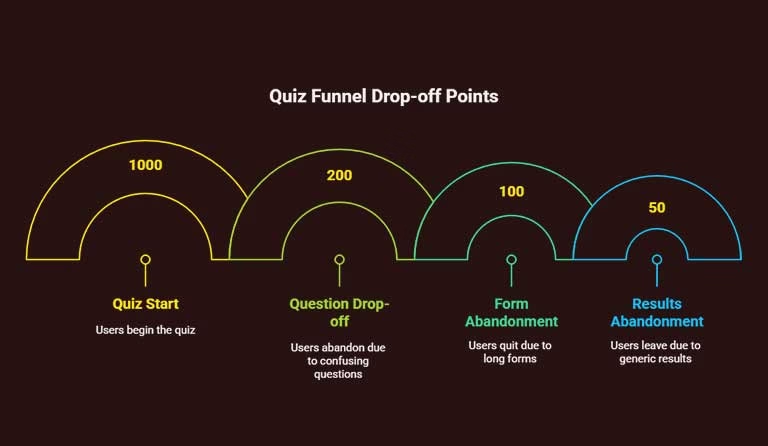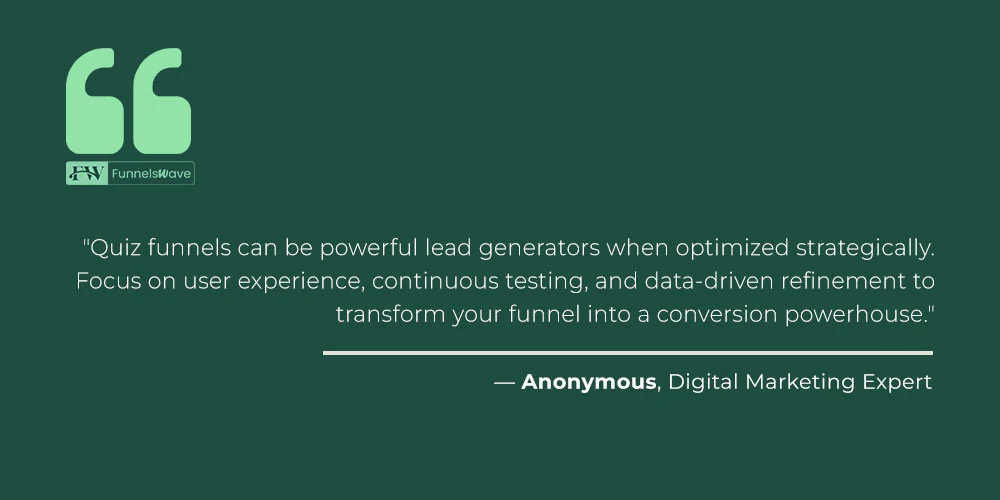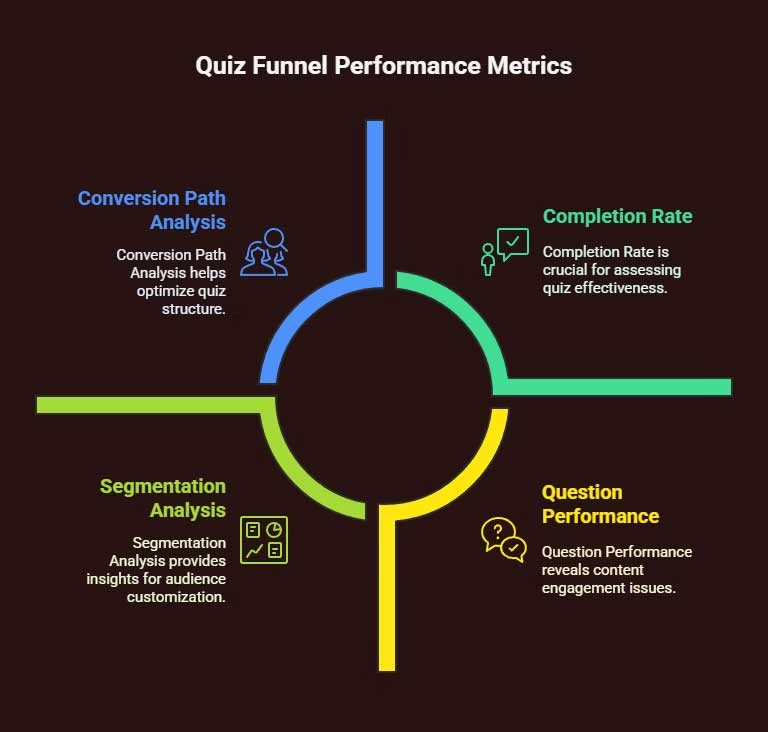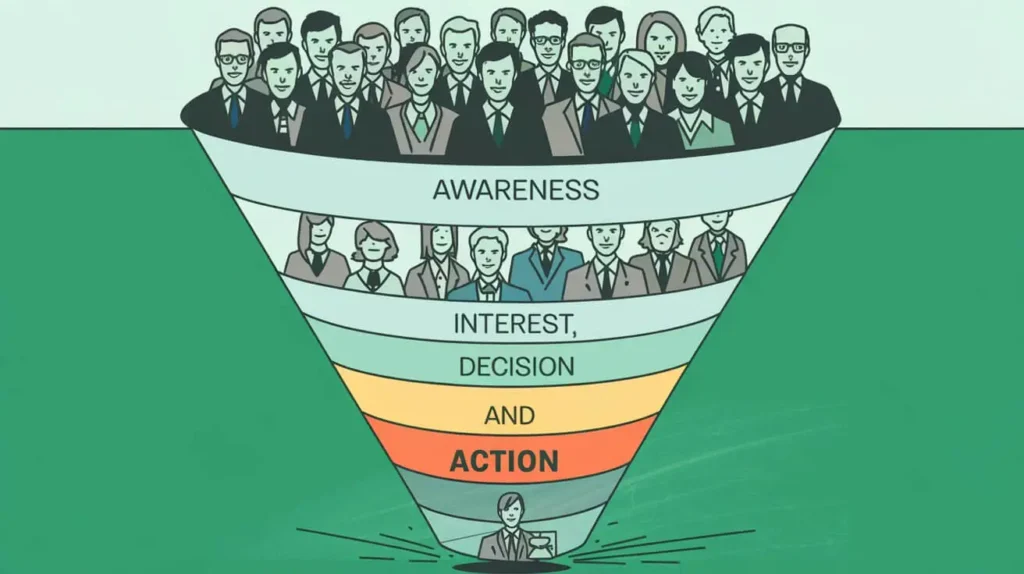Quiz funnels completion rates can reach an impressive 90-95%, as Buzzfeed’s user-generated quizzes showed. Many businesses have multiplied their email capture rates by 7.5 times when compared to traditional signup forms.
The results aren’t always this remarkable. Cup & Leaf’s email signups grew by 528% through smart quiz implementation, but many businesses can’t achieve these conversion rates with their quizzes.
We analyzed why quiz funnels fail to convert and found practical solutions to fix them. This piece will help you spot and solve the problems that limit your conversion rates. It doesn’t matter if you’re new to quiz marketing or want to boost your existing funnel’s performance.
Common Quiz Funnel Conversion Killers

Quiz funnels often fail to convert because they don’t account for basic user psychology. Users quickly abandon poorly designed quizzes that don’t align with their goals.
Poor question flow and progression
Your quiz questions should flow like a natural conversation. Research shows quizzes displayed across multiple screens convert 30% better than traditional forms. On top of that, each question needs to build on previous answers to create a logical flow that keeps users interested.
A winning sequence should:
- Begin with easy questions users want to answer
- Build complexity step by step
- Mix challenging questions between easier ones
- Add encouragement at key points

Complicated or confusing questions
Quiz takers constantly assess if questions are worth their time. Unclear or complex questions lead to quick abandonment. Data shows users tend to drop off when they face confusing options or too many choices.
Miller’s Law tells us people can only focus on 3-7 items at once. Too many answer choices per question can overwhelm users and hurt completion rates. The solution? Use predefined answer buttons instead of asking users to type responses.
Too many questions
Marketers still debate the perfect quiz length. Some experts suggest keeping quizzes between 7-10 questions, while others have seen 50% completion rates with 35-question quizzes. The number of questions matters less than how you organize them.
Make sure each question serves a clear purpose to create a successful quiz. Keep track of where users drop off to spot problems in your quiz flow. This information helps you smooth out complex sections that might cause friction.
Note that low purchase rates after quiz completion usually point to mismatched recommendations. Review your quiz logic to ensure you show products that match user responses. This attention to detail can boost your conversion rates substantially.
Why Your Quiz Questions Aren’t Working
Quiz questions need more than random questions thrown together. We focused on two critical factors that make quiz funnels successful: arranging them to match user intent and involving emotions.
Questions don’t match user intent
Quiz questions fail to convert when they don’t match what users want to learn or achieve. Research shows that multiple choice questions can assess learning outcomes of all types, from simple recall to application and analysis. In spite of that, these questions miss the mark when they don’t meet the quiz taker’s expectations or goals.
Questions that strike a chord with user intent need to:
- Support your stated learning objectives directly
- Remove irrelevant material that reduces reliability
- Measure actual understanding instead of testing memory tricks
- Skip unnecessary complexity that might overwhelm learners
Lack of emotional connection
Quiz questions fail most often because they don’t create emotional bonds with participants. Research shows that the main cause of relationship disconnection isn’t about technical aspects – it happens when emotional connections fail. This principle works the same way for quiz funnels.
Quiz questions create strong emotional connections when we understand how people process and answer them. Studies show quiz takers should feel safe being vulnerable with their answers. Questions should encourage openness and create chances for meaningful involvement.
Your quiz questions can build emotional connections by:
- Showing empathy and understanding in question framing
- Creating self-reflection opportunities
- Giving supportive feedback that acknowledges responses
- Exploring genuine areas of interest or concern
Quiz questions work best when they sound like natural conversations. Technical or overly formal language creates distance between the quiz and participant. Questions should flow naturally and build trust throughout the experience.
Emotional connections do more than make users feel good – they create meaningful interactions that lead to valuable insights. Your questions should balance professional expertise with personal relevance. Each response helps understand the user’s needs and priorities better.
Technical Issues Hurting Your Conversion Rate
Technical glitches can quietly derail even the best-designed quiz funnels. Research shows that nearly half of site visitors abandon pages loading longer than 3 seconds. Technical optimization becomes vital to success.
Slow loading times
Load speed directly affects how many people complete your quiz. Studies show 47% of visitors want pages to load within 2 seconds. The biggest slowdowns come from three main sources:
- Large, high-resolution images eating up bandwidth
- Too many third-party scripts creating extra HTTP requests
- Poorly optimized code that takes longer to process
Your quiz needs fewer scripts running at once. A content delivery network (CDN) helps serve content from servers closer to your visitors.
Mobile optimization problems
Most users take quizzes on their mobile devices. Poor mobile design can tank your completion rates. The most common mobile issues are:
Users getting frustrated by endless scrolling
Images breaking on smaller screens
Buttons that are too small to tap easily
Responsive design principles make mobile performance better. Keep all interactive elements above the fold on devices up to three generations old. Test your quiz on different screen sizes to spot display problems early.
Integration errors
Too many third-party tools and custom code create integration headaches. These problems hit quiz functionality hard when:
- Multiple tracking codes fight for resources
- Social media buttons create script conflicts
- Chat widgets block quiz progress
Combine multiple functions into single files to reduce external scripts. Take a full look at your tech stack to remove any redundant integrations.
Regular testing catches integration issues before they become problems. Watch your key metrics and drop-off points to find technical barriers in user progression. Smart optimization of these technical elements keeps quiz funnels running smoothly while giving users the personalized experience they expect.
Lead Capture Form Problems
Lead capture forms bridge the gap between quiz content and valuable user data. Research shows that quizzes average a 50% conversion rate for lead generation. Form optimization plays a vital role in success.
Asking for too much information
Form length affects completion rates directly. Studies show that cutting form fields from 11 to 4 made opt-ins jump by 120%. Keeping forms short and simple helps maintain high conversion rates.
The best number of fields falls between 3-5, with conversion rates reaching:
- 25% with three fields
- 20% with four or five fields
Your focus should be on collecting basic details like email addresses and first names. Additional information such as date of birth, gender, or company details should only be requested if they align with your business goals.
Poor timing of the opt-in
The placement of your lead capture form affects completion rates without doubt. Putting the form before the quiz creates two major problems:
Users might quit the quiz if they see the form too early. Quiz makers found that early form placement results in incomplete quiz data and limited context to personalize follow-ups.
The form works best when placed between the last question and results. This timing takes advantage of users’ peak emotional engagement as they want to see their results.
Many quiz creators make the mistake of showing forms at the start. This creates friction because visitors might think the quiz is free, only to feel frustrated when they need to share their information.
Your quiz funnel should:
- Build trust through engaging questions
- Show value through tailored interactions
- Show the lead capture form right before results
- Use minimal and relevant form fields
Note that quiz completion takes about three minutes per person. Longer quizzes risk higher abandonment rates, especially when lead capture forms appear at the end of a long sequence.
Results Page Optimization Issues

Personalized results pages are the life-blood of successful quiz funnels. Data shows that tailored recommendations can boost conversion rates by 469%. Many businesses find it hard to optimize this significant final step.
Generic recommendations
Your conversion rates drop when you use generic result pages through iFrames or pop-up windows. These clunky interfaces push users away from your conversion funnel and create a disjointed experience that reduces participation. Research shows that personalized product recommendations improve user satisfaction and demonstrate your brand’s attentiveness.
Result pages work better when you:
- Tailor recommendations based on quiz responses
- Inherit your brand’s design elements
- Display relevant testimonials and FAQs
- Include image galleries showcasing recommended products
Weak call-to-actions
Poor CTA button design hurts conversion rates badly. Studies show that personalized CTAs perform 202% better than generic ones. Quiz creators focus on question flow but often overlook button design and placement.
Your CTA’s success depends on:
- Strategic placement above the fold
- Clear, action-oriented language
- Visual hierarchy that makes the main CTA stand out
- Uninterrupted integration with your website’s design
Missing next steps
Quiz funnels fail to convert when users don’t get clear direction after seeing their results. Research shows that adding direct links from recommended products to checkout pages reduces cart abandonment. Successful quiz funnels must guide users through logical next steps.
Your results page should include:
- Clear action items
- Relevant resource links
- Additional support options
- Social proof elements
Tracking metrics helps optimize results page performance. Data shows that monitoring completion rates, cart additions, and average order values helps spot areas needing improvement. Good analytics let you refine your quiz funnel strategy continuously.
Successful results pages blend personalized recommendations with strong calls-to-action and clear next steps. Focus on these elements and maintain consistent tracking. Your quiz funnel can achieve much higher conversion rates this way.
Quiz Analytics and Tracking Mistakes
Analytics tracking shapes the foundation of any successful quiz funnel. Data shows how understanding user behavior and identifying friction points can boost conversion rates significantly.
Not tracking drop-off points
Quiz takers abandon their trip at critical points known as drop-off points. Research shows that analyzing these exit points helps identify questions that cause user disinterest or frustration. Modern analytics tools now provide features like:
- Heatmaps showing user interaction patterns
- Session recordings revealing step-by-step user behavior
- User flow analysis highlighting sticking points
A simple formula calculates drop-off rates: (Users leaving the funnel ÷ Total users entering the funnel) × 100. Businesses can spot problematic questions or technical issues that prevent completion by analyzing these rates.
To cite an instance, analyzing drop-off points becomes significant if your quiz completion rate falls below industry standards. Studies reveal that shorter quizzes perform better, as lengthy questionnaires discourage participants.
Missing key metrics
The success of quiz funnels depends on monitoring essential performance indicators. Here are vital metrics that often get overlooked:
Completion Rate: The number of users who finish versus those who start reveals quiz effectiveness. Low completion rates may point to issues with question relevance or quiz length.
Conversion Path Analysis: User navigation patterns help optimize the quiz structure. This data shows where users spend most time and which sections need work.
Question Performance: Analysis of individual questions reveals content engagement effectiveness. Consistently low average scores might indicate unclear content or poorly defined questions.
Segmentation Analysis: Metrics broken down by user behavior, traffic sources, and devices give deeper insights. This detailed view helps customize the quiz experience for different audience segments.
Integration Effectiveness: Quiz data should flow smoothly into marketing systems. Proper tracking ensures your sales team receives valuable lead information quickly.
Modern analytics platforms include User Abandonment tracking that pinpoints where quiz takers stopped and their progress stage. These insights allow precise optimization of problem areas.
Patterns in user responses deserve special attention during quiz performance analysis. Questions showing low engagement or unusual answer patterns consistently might need updates or replacement.
Note that consistent monitoring and swift improvements based on analytics are vital. Your quiz funnel can maintain peak performance and generate quality leads by implementing reliable tracking systems and fixing identified issues promptly.
Quick Fixes for Better Quiz Performance
Quiz funnels thrive on constant optimization and refinement. Product growth managers have achieved quiz completion rates up to 87% through experiments. These numbers show how strategic adjustments can substantially improve results.
Simplify your questions
Quiz optimization begins with well-laid-out questions based on extensive testing. Quizzes spread across multiple screens convert 30% better than traditional forms. Here’s how to improve question clarity:
- Keep options within Miller’s Law guidelines (3-7 choices)
- Use predefined button answers instead of text input
- Place sensitive questions between easier ones
- Add context before complex questions
The ideal quiz length ranges from 5-30 questions, and both ranges show similar completion rates. Strategic question placement and clear progression help maintain user engagement.
Improve page load speed
Technical performance plays a vital role in quiz success. Users have become more impatient, and their attention spans continue to decrease. Your load times will improve when you:
- Compress CSS, HTML, and JavaScript files larger than 150 bytes using Gzip
- Remove unnecessary characters from code
- Minimize HTTP request-response cycles
- Optimize server response time
- Implement content distribution networks (CDNs)
Mobile optimization remains essential since most traffic comes from mobile devices. Quiz funnels must prioritize mobile performance to maintain competitive conversion rates.
Add progress indicators
Progress bars are powerful tools that boost completion rates and reduce question drop-offs. They work exceptionally well because they:
- Help users understand their position in the quiz
- Reduce abandonment on longer quizzes
- Provide visual motivation to complete all questions
Place your progress bar where it works best. You can position it above or below quiz questions based on your design priorities. Match the progress bar with your brand colors while keeping it clearly visible.
Progress indicators can show information in several ways:
- Percentage completed
- Questions remaining
- Step-by-step progression
- Custom progress messaging
Quizzes with multiple sections benefit from information context between question sets. This approach keeps users involved while offering natural breaks in the quiz flow. Limit these contextual breaks to about 30% of the quiz to maintain momentum.
Successful quiz optimization combines simple questions, fast loading speeds, and clear progress indicators. Your quiz funnel can achieve higher engagement levels by implementing these improvements and tracking completion rates. Good analytics tracking paired with these optimizations creates an intuitive experience that drives completion and conversion.
Testing and Optimization Strategies
Systematic testing serves as the foundation of any high-performing quiz funnel. The data proves that A/B testing can transform a money-losing campaign into a profitable one.
A/B testing key elements
Split testing, also called A/B testing, lets marketers compare two versions of the same marketing asset to find the best performer. This approach helps businesses test:
- Pricing strategies and positioning
- Product recommendations and displays
- Checkout experiences and friction points
- Landing page elements and messaging
Successful A/B testing needs a systematic approach to experimentation. You might test a minimalist design that focuses on key details against another version that includes customer reviews and interactive elements.
Split testing’s strength lies in revealing what your audience wants through evidence-based results. To cite an instance, testing different quiz styles—comparing conversational language with product-specific terminology—can show which approach works better with your audience.
Testing various incentives proves valuable too. Some businesses succeed with discounts, while others get better results from free resources. Success comes from tracking completion rates and user feedback to find winning combinations.
Conversion rate benchmarks
Industry benchmarks help you measure quiz funnel performance better. Recent data shows the average conversion rate from quiz-start to email opt-in reaches 40.1%. Quiz funnels can increase conversion rates from 2% to 5% with proper implementation.
These key metrics matter when measuring quiz performance:
Completion Rate: This basic metric shows how engaging and user-friendly your quiz is. Higher completion rates mean users find the content relevant and easy to use.
Cart Value: Cart count and total value tracking helps review product recommendation effectiveness. High cart values indicate that your product suggestions appeal to users.
Purchase Rate: This number shows how many users buy after getting recommendations. Low purchase rates might point to irrelevant product suggestions or broken quiz logic.
Your performance monitoring should include these tracking strategies:
- Regular quiz response data exports for detailed analysis
- Customer behavior monitoring through event tracking
- Most-clicked choices and elements analysis
- Customer tags tracking for effective segmentation
GA4 integration offers deeper insights into quiz performance and lets businesses track specific events like:
- Choice clicks
- Question interactions
- Open question responses
- Product description engagement
Testing and tracking implementation helps businesses spot user behavior trends and make improvements. Users who consistently skip certain questions signal that these questions need revision.
Quiz funnel optimization becomes more powerful when combined with social media advertising. Jones Road Beauty generated seven-figure revenue by combining their quiz strategy with TikTok ads. Their average order value jumped 50% through strategic quiz implementation.
These benchmark targets can help maintain competitive performance:
- Quiz completion rates between 60-70%
- Top-performing quizzes achieve 90% completion
- Quiz taker conversion rates should range from 8% to 25%
Traffic source affects conversion rates significantly. Earned traffic converts better than paid traffic, making organic quiz visibility a vital focus. Continuous metric monitoring and evidence-based adjustments help businesses maximize their quiz funnel effectiveness.
Conclusion
Quiz funnels serve as effective lead generation tools with proper optimization. Many businesses face low conversion rates. Understanding problems like poor question flow, technical glitches, and weak results pages helps create targeted solutions.
Data shows successful quiz funnels reach completion rates of 60-70%, with top performers hitting 90%. Businesses should focus beyond question count. User experience matters more through simple questions, clear progress indicators, and quick loading times.
Testing proves vital to quiz optimization. A/B testing different elements and tracking metrics helps find winning combinations that appeal to your audience. Monitoring drop-off points and user behavior patterns quickly reveals problem areas.
Quiz success relies on constant refinement based on analytics. Start with the fixes outlined in this piece and measure results against industry standards. Regular optimization and testing can turn your quiz funnel from an underperforming asset into a reliable source of qualified leads.
FAQs
Are quiz funnels effective for lead generation?
Quiz funnels can be highly effective for lead generation when properly optimized. Well-designed quizzes can achieve completion rates of 60-70%, with top performers reaching 90%. They provide an engaging and personalized experience for potential customers while gathering valuable contact information and insights about user preferences.
How can I improve my quiz funnel’s conversion rate?
To improve your quiz funnel’s conversion rate, focus on simplifying questions, improving page load speed, and adding clear progress indicators. Implement A/B testing to optimize key elements, ensure mobile responsiveness, and create personalized result pages with strong calls-to-action. Regularly analyze drop-off points and user behavior to identify areas for improvement.
What are some common mistakes in quiz funnel design?
Common mistakes in quiz funnel design include poor question flow, complicated or confusing questions, too many questions, slow loading times, and generic recommendations on result pages. Additionally, asking for too much information in lead capture forms and placing them at the wrong time can significantly hurt conversion rates.
How many questions should my quiz have?
The optimal quiz length can vary, but generally, quizzes with 5-30 questions show similar completion rates. The key is to maintain user engagement through strategic question placement and clear progression. Focus on creating a balanced quiz that provides value to the user while gathering necessary information for your business.
What metrics should I track to measure quiz funnel performance?
Key metrics to track include completion rate, conversion path analysis, question performance, and segmentation analysis. Also, monitor drop-off points, cart value, and purchase rate. For deeper insights, consider implementing GA4 integration to track specific events like choice clicks, question interactions, and product description engagement. Regularly compare your performance against industry benchmarks for continuous improvement.










